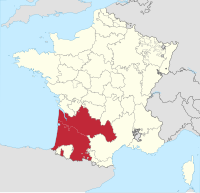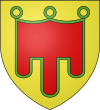| Pre-1789
|
Departments
|
| Number (on map)
|
Coat of Arms
|
Reignal Name
|
Type of Region
|
Sub-Elements
|
Map
|
Establishment/Incorporation date[a]
|
Capital
|
Information
|
Successor(s)[b]
|
Map
|
| Duchies
|
| #15
|

|
Duchy of Anjou
|
Duchy
|
|

|
1482
|
Angers
|
Created in 1482
|
- Deux-Sèvres (Following communes only: Saint-Pierre-des-Échaubrognes and Marnes)
- Indre-et-Loire (Following communes only: Avrillé-les-Ponceaux, Benais, Bourgueil, Braye-sur-Maulne, Channay-sur-Lathan, La Chapelle-sur-Loire, Continvoir, Couesmes, Courcelles-de-Touraine, Gizeux, Hommes, Lublé, Marcilly-sur-Maulne, Restigné, Rillé, Saint-Laurent-de-Lin, Saint-Nicolas-de-Bourgueil, Savigné-sur-Lathan, Villiers-au-Bouin, Assay, Braslou, Braye-sous-Faye, Champigny-sur-Veude, Chaveignes, Courcoué, Faye-la-Vineuse, Jaulnay. Marçay, Razines, Richelieu, and Luzé)
- Loire-Atlantique (Only the commune of La Boissière-du-Doré)
- Maine-et-Loire
- Mayenne (Following communes only: Ampoigné, Argenton-Notre-Dame, Athée, Azé, Ballots, Bierné, La Boissière, Bouchamps-lès-Craon, Brains-sur-les-Marches, La Chapelle-Craonnaise, Château-Gontier, Châtelain, Chemazé, Chérancé, Congrier, Cosmes, Cossé-le-Vivien, Coudray, Craon, Cuillé, Daon, Denazé, Entrammes, Fontaine-Couverte, Fromentières, Gastines, Gennes-sur-Glaize, Grez-en-Bouère, Houssay, Laigné, Laubrières, Livré-la-Touche, Loigné-sur-Mayenne, Longuefuye, Maisoncelles-du-Maine, Marigné-Peuton, Mée, Ménil, Méral, Niafles, Nuillé-sur-Vicoin, Origné, Peuton, Pommerieux, Quelaines-Saint-Gault, Renazé, La Roë, La Rouaudière, Ruillé-Froid-Fonds, Saint-Aignan-sur-Roë, Saint-Denis-d'Anjou, Saint-Erblon, Saint-Fort, Saint-Laurent-des-Mortiers, Saint-Martin-du-Limet, Saint-Michel-de-Feins, Saint-Michel-de-la-Roë, Saint-Poix, Saint-Quentin-les-Anges, Saint-Saturnin-du-Limet, Saint-Sulpice, La Selle-Craonnaise, Senonnes, Simplé, and Villiers-Charlemagne)
- Sarthe (Following communes only: Pincé, Arthezé, Le Bailleul, Bazouges-sur-le-Loir, Boussès, La Bruère-sur-Loir, La Chapelle-aux-Choux, La Chapelle-d'Aligné, Chenu, Courtillers, Cré-sur-Loir, Crosmières, Dissé-sous-le-Lude, Dureil, La Flèche, Louailles, Le Lude, Parcé-sur-Sarthe, Notre-Dame-du-Pé, Précigné, Saint-Germain-d'Arcé, Savigné-sous-le-Lude, Thorée-les-Pins, Vaas, Villaines-sous-Malicorne, and Vion)
- Vienne (Following communes only: Amberre, Angliers, Arçay, Aulnay, Basses, Berrie, Berthegon, Beuxes, Blaslay, Bournand, Ceaux-en-Loudun, Chalais, Champigny-le-Sec, La Chaussée, Cherves, Chouppes, La Roche-Rigault, Coussay, Craon, Cuhon, Curçay-sur-Dive, Dercé, Glénouze, La Grimaudière, Guesnes, Loudun, Maisonneuve, Martaizé, Massognes, Maulay, Mazeuil, Messemé, Mirebeau, Moncontour, Monts-sur-Guesnes, Morton, Mouterre-Silly, Nueil-sous-Faye, Pouançay, Pouant, Prinçay, Ranton, Raslay, Roiffé, Saint-Clair, Saint-Jean-de-Sauves, Saint-Laon, Saint-Léger-de-Montbrillais, Saires, Saix, Sammarçolles, Savigny-sous-Faye, Ternay, Thurageau, Les Trois-Moutiers, Varennes, Verrue, Vézières, and Vouzailles)
|

|
| #12
|

|
Combined Government of Guyenne and Gascony
|
Duchy
|
Duchy of Guyenne (Guiana)

|

|
1453
|
Bordeaux
|
Combined for administrative purposes in the 17th century. Split into two separate duchies in 1789, but continued as a combined authority.
|
|

|

|
Duchy of Gascony (Gasconha, Gascunya)

|
Auch
|
- Ariège (Following communes only: Aleu, Alos, Antras, Argein, Arrien-en-Bethmale, Arrout, Aucazein, Audressein, Augirein, Aulus-les-Bains, Bagert, Balacet, Balaguères, Barjac, La Bastide-du-Salat, Bédeille, Betchat, Bethmale, Biert, Bonac-Irazein, Les Bordes-sur-Lez, Boussenac, Buzan, Castillon-en-Couserans, Caumont, Cazavet, Cérizols, Cescau, Contrazy, Couflens, Encourtiech, Engomer, Ercé, Erp, Eycheil, Fabas, Gajan, Galey, Illartein, Lacave, Lacourt, Lasserre, Lescure, Massat, Mauvezin-de-Prat, Mauvezin-de-Sainte-Croix, Mercenac, Mérigon, Montardit, Montégut-en-Couserans, Montesquieu-Avantès, Montgauch, Montjoie-en-Couserans, Moulis, Orgibet,, Oust, Le Port, Prat-Bonrepaux, Rimont, Rivèrenert, Sainte-Croix-Volvestre, Saint-Girons, Saint-Jean-du-Castillonnais, Saint-Lary, Saint-Lizier, Salsein, Seix, Lorp-Sentaraille, Sentein, Sentenac-d'Oust, Sor, Soueix-Rogalle, Soulan, Taurignan-Castet, Taurignan-Vieux, Tourtouse, Uchentein, Ustou, and Villeneuve)
- Gers
- Gironde (Following communes only: Aillas, Andernos-les-Bains, Arès, Aubiac, Audenge, Auros, Balizac, Barie, Le Barp, Bassanne, Bazas, Belin-Béliet, Berthez, Bieujac, Biganos, Birac, Blaignac, Bourideys, Brannens, Brouqueyran, Captieux, Castets-en-Dorthe, Castillon-de-Castets, Cauvignac, Cazalis, Cazats, Coimères, Cours-les-Bains, Cudos, Escaudes, Floudès, Fontet, Gajac, Gans, Giscos, Goualade, Grignols, Guillos, Gujan-Mestras, Hostens, Hure, Labescau, Lados, Landiras, Langon, Lanton, Lartigue, Lavazan, Lège-Cap-Ferret, Lerm-et-Musset, Lignan-de-Bazas, Louchats, Loupiac-de-la-Réole, Lucmau, Lugos, Marimbault, Marions, Masseilles, Mazères, Mios, Le Nizan, Noaillac, Origne, Porchères, Pondaurat, Le Porge, Puybarban, Saint-Côme, Saint-Léger-de-Balson, Saint-Loubert, Saint-Michel-de-Castelnau, Saint-Michel-de-Rieufret, Saint-Pierre-de-Mons, Saint-Symphorien, Salles, Saucats, Sauviac, Savignac, Sendets, Sigalens, Sillas, Le Teich, La Teste-de-Buch, Le Tuzan, Uzeste, and Marcheprime.)
- Haute-Garonne (Following communes only: Agassac, Alan, Ambax, Anan, Antichan-de-Frontignes, Antignac, Arbas, Arbon, Ardiège, Arguenos, Argut-Dessous, Arlos, Arnaud-Guilhem, Artigue, Aspet, Aspret-Sarrat, Aulon, Aurignac, Ausseing, Ausson, Auzas, Bachas, Bachos, Bagiry, Bagnères-de-Luchon, Balesta, Barbazan, Baren, Beauchalot, Beaufort, Belbèze-en-Comminges, Bellegarde-Sainte-Marie, Bellesserre, Benque, Benque-Dessous-et-Dessus, Bezins-Garraux, Billière, Blajan, Bois-de-la-Pierre, Boissède, Bonrepos-sur-Aussonnelle, Bordes-de-Rivière, Boudrac, Boulogne-sur-Gesse, Bourg-d'Oueil, Boussan, Boussens, Boutx, Bouzin, Bragayrac, Bretx, Brignemont, Burgalays, Le Burgaud, Cabanac-Cazaux, Cabanac-Séguenville, Cadours, Cambernard, Cardeilhac, Cassagnabère-Tournas, Cassagne, Castagnède, Castelbiague, Castelgaillard, Castelnau-Picampeau, Le Castéra, Castéra-Vignoles, Casties-Labrande, Castillon-de-Larboust, Castillon-de-Saint-Martory, Cathervielle, Caubiac, Caubous, Cazarilh-Laspènes, Cazaril-Tambourès, Cazaunous, Cazaux-Layrisse, Cazeaux-de-Larboust, Cazeneuve-Montaut, Cirès, Cazères, Charlas, Chaum, Chein-Dessus, Ciadoux, Cier-de-Luchon, Cier-de-Rivière, Cier-de-Rivière, Cierp-Gaud, Clarac, Coueilles, Couladère, Couret, Cox, Cuguron, Le Cuing, Daux, Drudas, Eaunes, Empeaux, Encausse-les-Thermes, Eoux, Escanecrabe, Esparron, Estadens, Eup, Fabas, Le Fauga, Figarol, Fonsorbes, Fontenilles, Forgues, Fos, Fougaron, Francazal, Francon, Franquevielle, Le Fréchet, Fronsac, Frontignan-de-Comminges, Frontignan-Savès, Frouzins, Fustignac, Galié, Ganties, Garac, Garin, Génos, Gensac-de-Boulogne, Gensac-sur-Garonne, Gouaux-de-Larboust, Gouaux-de-Luchon, Goudex –
- Hautes-Pyrénées (Following communes only:
- Landes (Following communes only:
- Lot-et-Garonne (Following communes only:
- Pyrénées-Atlantiques (Following communes only:
- Tarn-et-Garonne (Following communes only:
|

|
| #13
|

|
Duchy of Burgundy
(Borgoigne, Borgoègne, Bregogne, Borgogne)
|
Duchy
|
|

|
1477
|
Dijon
|
Created as a Captain-Duchy in 1477.
|
|

|
| #34
|

|
Duchy of Nivernais (Nivarnois)
|
Duchy
|
|

|
1789
|
Nevers
|
"Dependent on the Kingdom of France" until 1789, and then absorbed into the Kingdom as a Duchy.
|
- Cher (Following communes only: Jouet-sur-l'Aubois, Cours-les-Barres, Torteron, Cuffy, Le Chautay, La Guerche-sur-l'Aubois, Apremont-sur-Allier, and Neuvy-le-Barrois)
- Nièvre
- Yonne (Following communes only: Druyes-les-Belles-Fontaines, Étais-la-Sauvin, Sainpuits, and Sougères-en-Puisaye)
|

|
| #4
|

|
Duchy of Normandy(Normandie, Normaundie)
|
Duchy
|
Perche
|

|
1204
|
Rouen
|
Duchy of Normandy created in 911 and taken into France in 1204.
|
|

|
| Counties
|
| #17
|

|
County of Angoumois (Angoumois, Engolmés)
|
County
|
|

|
1514
|
Angoulême
|
Fife of the old Duchy of Aquitaine, separated on formation of the Duchy of Guyenne in 1514.
|
- Charente
- Deux-Sèvres (Following communes only: Loubillé, Montalembert, and Valdelaume)
- Dordogne (Following communes only: Champagne-et-Fontaine, Gout-Rossignol, La Chapelle-Montabourlet, La Roche-Chalais, La Tour-Blanche-Cercles, Parcoul-Chenaud, and Saint-Aulaye-Puymangou)
- Haute-Vienne (Following communes only: Chéronnac, Cussac, Dournazac, La Chapelle-Montbrandeix, Les Salles-Lavauguyon, Maisonnais-sur-Tardoire, Marval, Oradour-sur-Vayres, Pensol, Saint-Bazile, Saint-Mathieu, Vayres, and Videix)
|

|
| #28
|

|
County of Artois (Artoés, Artesië)
|
County
|
|

|
1659
|
Arras
|
Absorbed into the Kingdom of France in 1659 following the Treaty of the Pyrenees
|
|

|
| #25
|

|
County of Auvergne (Auvèrnha)
|
County
|
|

|
1457
|
Clermont-Ferrand
|
Formed in 1457 by splitting the Merovingian county of the Duchy of Aquitaine, also Carolingian part.
|
- Allier (Following communes only: Abrest, Barberier, Bayet, Bègues, Bellenaves, Busset, Cesset, Chantelle, Chareil-Cintrat, Charroux, Chezelle, Chirat-l'Église, Chouvigny, Coutansouze, Cusset, Deneuille-lès-Chantelle, Ébreuil, Échassières, Étroussat, Fleuriel, Fourilles, Hauterive, Jenzat, Lalizolle, Loriges, Louchy-Montfand, Louroux-de-Bouble, Marcillat-en-Combraille, Mariol, Monestier, Montord, Nades, Naves, Paray-sous-Briailles, Saint-Bonnet-de-Rochefort, Saint-Christophe, Saint-Didier-la-Forêt, Saint-Fargeol, Saint-Germain-de-Salles, Saint-Marcel-en-Marcillat, Saint-Pourçain-sur-Sioule, Saint-Yorre, Sussat, Target, Taxat-Senat, Le Theil, Ussel-d'Allier, Valignat, Veauce, Le Vernet, Vicq, and Voussac)
- Cantal
- Haute-Loire (Following communes only: Agnat, Allègre, Ally, Arlet, Aubazat, Vissac-Auteyrac, Autrac, Auzon, Azérat, Beaumont, Beaune-sur-Arzon, Bellevue-la-Montagne, Berbezit, Blassac, Blesle, Bonneval, Bournoncle-Saint-Pierre, Brioude, Céaux-d'Allègre, Cerzat, La Chaise-Dieu, Chambezon, Champagnac-le-Vieux, Chaniat, Chanteuges, La Chapelle-Geneste, Charraix, Chassagnes, Chassignolles, Chastel, Chavaniac-Lafayette, Chazelles, Chilhac, Chomelix, La Chomette, Cistrières, Cohade, Collat, Connangles, Couteuges, Cronce, Desges, Domeyrat, Espalem, Félines, Ferrussac, Fontannes, Frugerès-les-Mines, Frugières-le-Pin, Grenier-Montgon, Javaugues, Josat, Jullianges, Lamothe, Langeac, Laval-sur-Doulon, Lavaudieu, Lavoûte-Chilhac, Lempdes-sur-Allagnon, Léotoing, Lorlanges, Lubilhac, Malvières, Mazerat-Aurouze, Mazeyrat-d'Allier, Mercœur, Monlet, Montclard, Paulhac, Paulhaguet, Pébrac, Pinols, Prades, Saint-Arcons-d'Allier, Saint-Austremoine, Saint-Beauzire, Saint-Cirgues, Saint-Didier-sur-Doulon, Saint-Étienne-sur-Blesle, Sainte-Eugénie-de-Villeneuve, Sainte-Florine, Saint-Geneys-près-Saint-Paulien, Saint-Georges-d'Aurac, Saint-Géron, Saint-Hilaire, Saint-Ilpize, Saint-Jean-d'Aubrigoux, Saint-Julien-des-Chazes, Saint-Just-près-Brioude, Saint-Laurent-Chabreuges, Sainte-Marguerite, Saint-Pal-de-Senouire, Saint-Paulien, Saint-Préjet-Armandon, Saint-Privat-du-Dragon, Saint-Vert, Saint-Victor-sur-Arlanc, Salzuit, Sembadel, Siaugues-Sainte-Marie, Tailhac, Torsiac, Vals-le-Chastel, Vergongheon, Vézézoux, Vieille-Brioude, and Villeneuve-d'Allier)
- Puy-de-Dôme
|

|






























